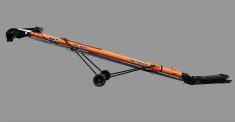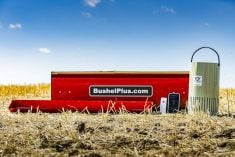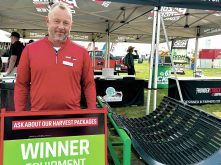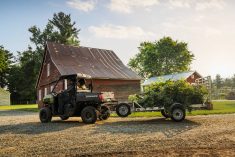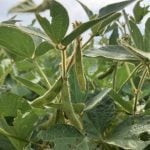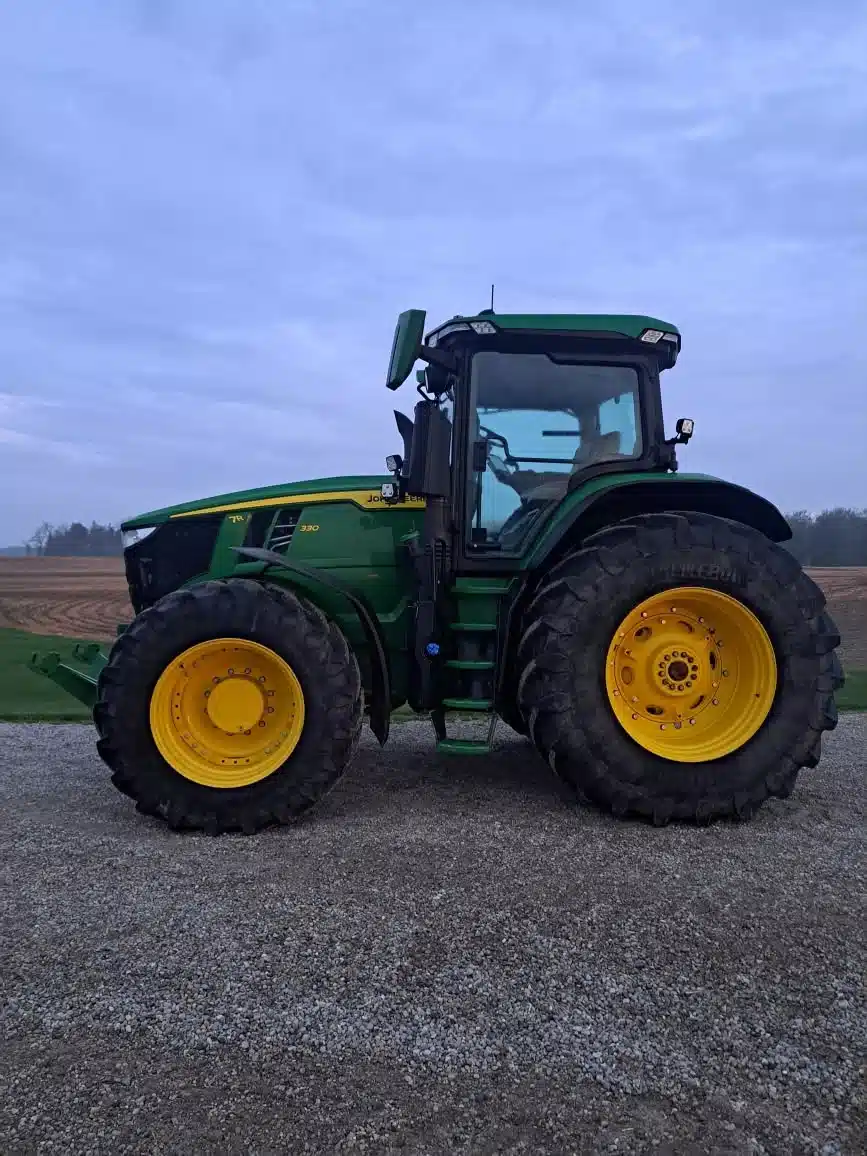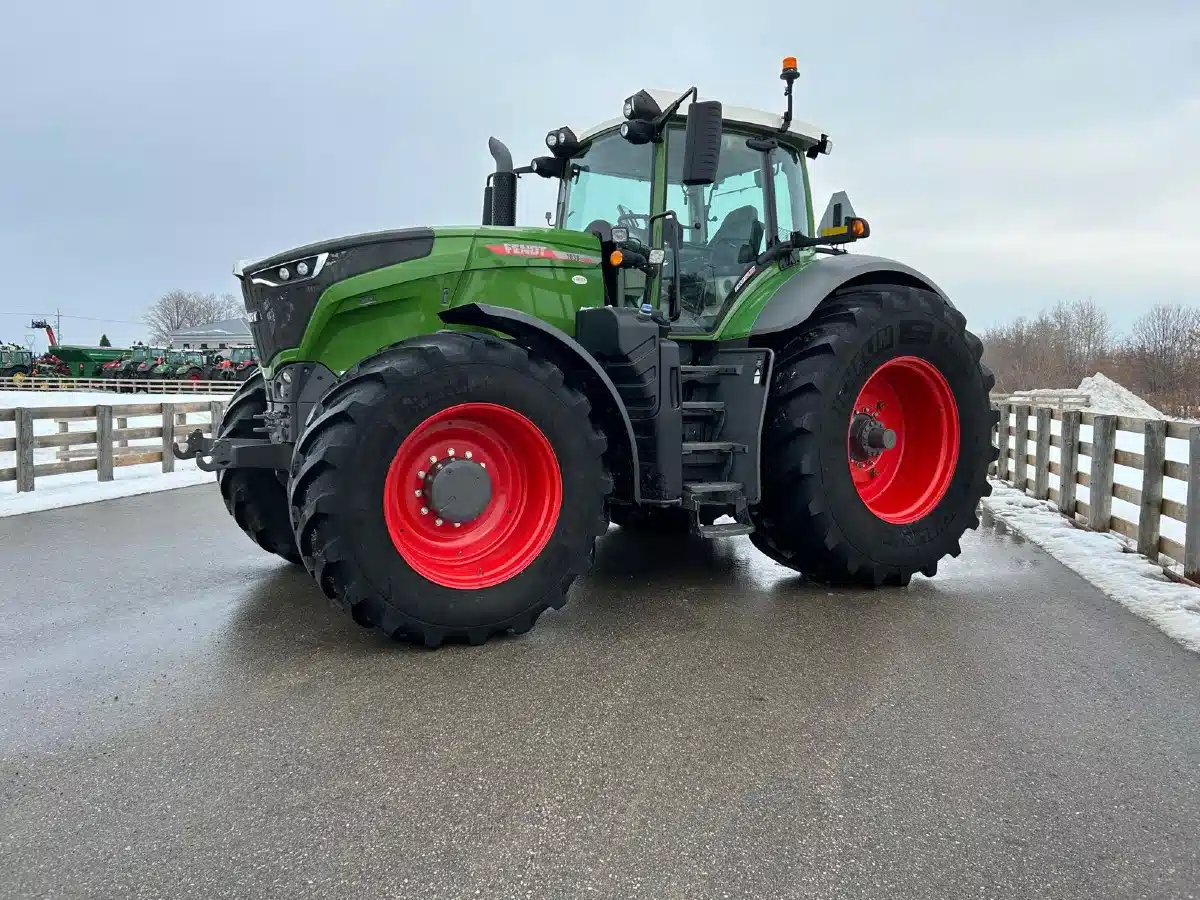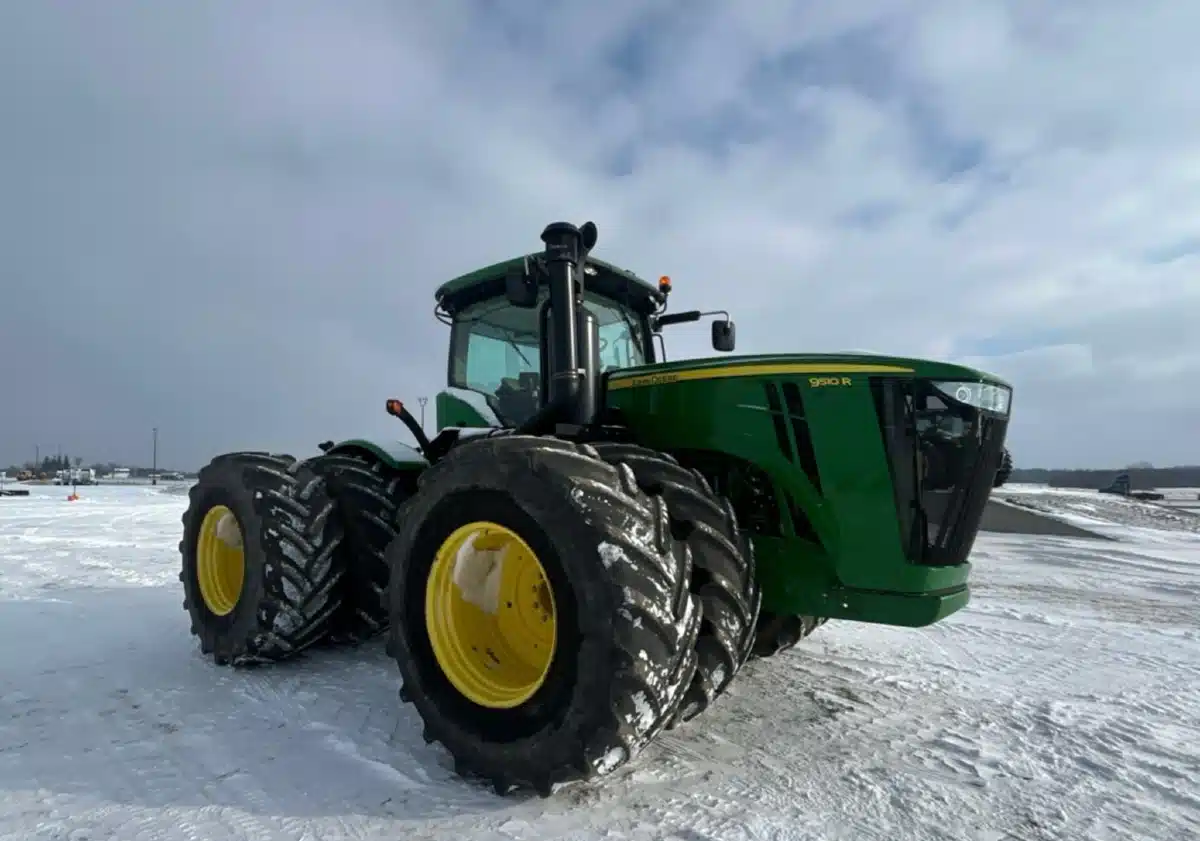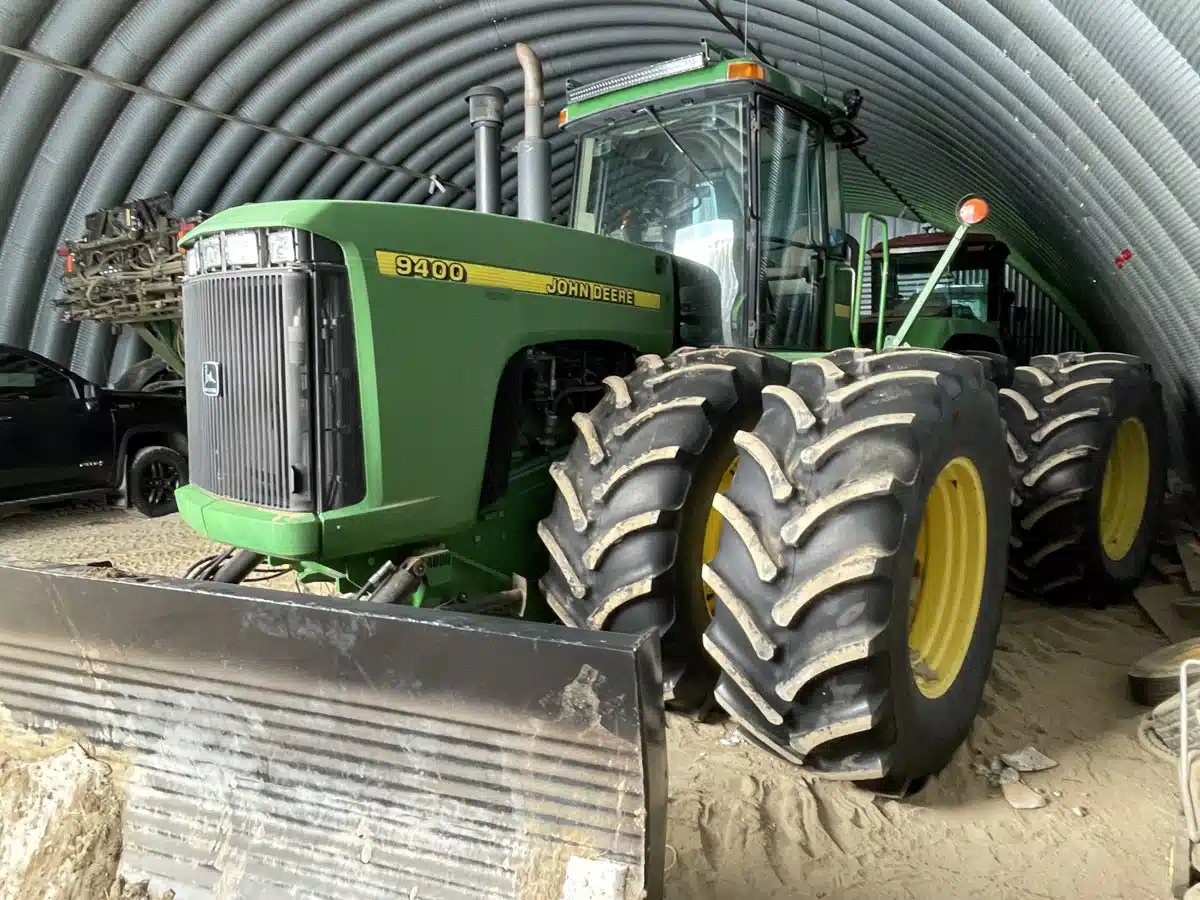What’s old can be like new again, says the president of a Saskatchewan company that specializes in helping producers outfit older farm machinery with the latest in precision farming technology.
Matthew Yanick, who founded Rocanville, Sask.-based MY Precision Ag, spoke at the recent Manitoba Ag Days farm show in Brandon about the benefits of equipping older farm machinery with the latest tech products and how, in some cases, it can be a cost-effective alternative to buying new machines.
“I sometimes say your machinery of tomorrow may already be in your shed today,” says Yanick, whose company has customers across Canada as well as the northern U.S. “I’m not saying don’t go buy new machinery. New machinery is great. This is just a second option.”
Read Also

Claas brings 1000 Series SP forage harvesters to Canada
In mid-August, Claas unveiled its new line of Jaguar forage harvesters at an event in Visalia, California, deep in the heart of that state’s dairy region.
The biggest advantage to upgrading an existing piece of equipment instead of buying new is cost saving, he says. Technological add-ons cost a fraction of the price of most new equipment.
READ MORE: Expensive new equipment or older/cheaper: Which makes more sense?
And those costs continue to climb — a recent report from Manitoba Agriculture estimated the cost of farm equipment increased by between 25 and 62 per cent in the past two years.
“New stuff gets more and more expensive every year, interest rates get higher every year, payments get bigger. No one wants that big payment if they already have something that’s paid off sitting in the shed that can do what they want it to do,” Yanick says.
And upgrading existing machinery can also save on input costs, boost yields, provide more precise data tracking and reduce the chances of crop lodging with the addition of sectional control and variable rate systems, he says.
It can also mean considerably less wear and tear on the machine’s human operator.
“You’re going to be less tired at the end of the day because you have a more efficient machine,” he said. “You’re not hitting as many switches…and with autosteer you’re not trying to keep it on a straight line using a fence post like 20 years ago.”
You won’t get any argument on benefits of upgrading existing equipment from Jake Ayre, who operates a family-owned grain and seed farm near Minto, Man. In today’s ag climate, he says, producers have a business responsibility to look at how they can increase the efficiency of their operations while keeping a handle on costs.
“(Machine upgrades) are definitely something we look at all the time,” he said in an interview. “Sometimes the inclination is to upgrade that piece of machinery to a newer model. But there is a variety of upgrade kits that you can put on that piece to either improve the efficiency or improve how things are done.”
Ayre pointed to an example on his own farm. He found the air drill he used was producing too much air pressure in the seeding lines, which resulted in seeds hitting the row, then bouncing out and landing on top of the soil.
Last spring he decided to install a D-Cup Diffuser, an Australian product, in the air drill, eliminating that high-speed air flow in the seeding lines. The result was an improved seeding rate and drastically fewer ungerminated seeds.
Steven Donald operates a mixed grain and cattle farm near Moosomin, Sask. He’s also a journeyman ag mechanic — and an advocate for using technology to increase existing farm machinery’s capabilities.
“The only thing you’re gaining with buying a brand-new piece of equipment is hours,” he said in an interview. “I’ve actually found that the accuracy on some of our (upgraded) systems are even better than a factory-installed system.”
He cites the example of the real-time kinematics (RTK) system he installed on his own farm, which has allowed him to use an existing air seeder for sectional control and variable rate fertilizer application.
“I’m doing all the things that these fancy new machines do,” he says.
Do your homework
However, Yanick cautions producers to do their homework before investing in new technology for older equipment.
One of the first things you should do, he says, is investigate whether your existing machine is compatible with some of the newer precision ag technologies that are available.
That includes making sure your machine is big enough, and powerful enough, to handle whatever technological upgrades you’re looking to make.
“You don’t want to sink a lot of money into something if it’s only going to work for you for one year and you’re trying to grow your operation,” he adds.
“In the case of a tractor, does it have enough horsepower for your current needs and the next couple of years? It’s the same for combines. Is my combine big enough to do the acres per hour I need, or am I better off to buy a bigger combine or find a secondary combine?”
Ayre agrees. Information about most upgrade kits is available on the manufacturers’ websites, he says, and many users post reviews on the products on social media platforms such as Reddit and Facebook.
He also suggests checking with manufacturers directly, as most have a precision ag or tech specialist who can answer questions about options available for their product lines.
Compatibility is also a key consideration when upgrading existing machinery. Yanick says some models can be much easier to upgrade than others, and you should check with your dealers to make sure any tech kit you’re considering can do the job you want to have done.
It’s also important to carefully consider the state of whatever piece of equipment you’re looking to upgrade — and that it has “lot of life left on the hour meter.
“Sometimes people come to us and say we’re having this issue and they think putting something new in is going to fix it, but a lot of times that issue will carry over because something on the machine is (working incorrectly),” he says.
“In that case, the last thing you want is to spend a bunch of money on something you already have and then have it not work because you have a pre-existing issue.”
You should also consider the cost of any upgrades you’re looking to add, versus the cost of buying a newer unit that already has those features on it, he says. Some upgrades can cost a substantial amount of cash, depending on the machine and what you may be trying to add to it.

What are my options?
So, where should you start if you are considering upgrading a piece of existing machinery?
Yanick suggests taking a look at the machinery on hand and considering the options available. Most tractors, air seeders and planters, sprayers, liquid and NH3 applicators, combines and grain carts can be upgraded.
Tractors
Some of the most popular upgrades for tractors are precision farming displays, global navigation satellite system (GNSS) receivers, autosteer, and machine sync and data transfer systems.
Yanick says monitors are the “true heart and soul” of any precision farming system, and it’s important to choose one capable of doing what you want it to do.
It’s also important to choose a monitor fully compatible with the machine it’s being installed on — and with a big enough screen that you won’t be straining your eyes all day long.
“If you have older operators where their vision isn’t there anymore, don’t go buy the smallest monitor just so you can save a little money,” he said. “I personally like the bigger displays. They just make everything easier. They’re more future-friendly.”
Choosing the right GNSS receiver is important, Yanick says, because everything from sectional and variable rate control to autosteer is linked to that unit. Newer GNSS receivers have upgraded boards, meaning they can link to more satellites and are more reliable. Many require an annual subscription.

Autosteer is one of the building blocks to maximizing the efficiency of any machine and Yanick recommends working with a dealer to find a kit that’s right for the device you are looking to upgrade. If the unit is guidance-ready, some manufacturers offer kits to reuse those factory components. Hydraulic autosteer systems are recommended for sub-inch accuracy applications as they are the most responsive.
Telematics, such as machine syncing and data transfer, can be added to compatible monitors and provide a range of features including remote software updates, machine-to-machine map and data sharing, office-to-machine data transfer, and machine-to-office data transfer.
Yanick says they are a great tool in instances where multiple machines are working in sync in the same fields and working off each other’s maps for application and sectional control. Most typically require some form of cellphone plan.
Air seeders and planters
Yanick says his company receives a high number of inquiries from customers wanting to upgrade an existing air seeder or planter. The most common request is to add variable rate capability for seed and granular fertilizer.
The two options are to buy a kit that is already available or to custom-build one. An upside to adding one of these kits to a machine is that it can be integrated into a tractor’s existing display, which can eliminate the need for a lot of old wiring and multiple monitors.
Sectional control on existing seeders and planters is also in increasing demand. Yanick says it can pay for itself very quickly through savings in input costs and less lodging. One downside is the available options right now are quite limited, although most can be installed fairly easily.
Blockage and flow monitoring systems can be a great investment for existing air drills, Yanick says. Most kits are very similar to factory-installed systems. Not only do they show if a line is plugged, but they can also indicate if one tower is putting out more product than another and if your rate is starting to fluctuate — things many air seeder monitors might not catch. Upgrade kits are available for units manufactured as far back as the 1990s, he adds.
Hydraulic downforce units allow planters to adjust almost instantly as field conditions change and ensure proper seeding depth at all times on every row throughout a field. Yanick says they are much more effective than existing manual springs or airbags, which can take up to 20 seconds to change in field conditions.
“With consistent downforce and consistent seed depth, you’re getting consistent emergence, you’re getting proper seed placement, you’re getting everything you want, especially with corn,” he said.

Sprayers
In addition to display units, GNSS receivers, autosteer and telematics, potential upgrades to sprayers include pulse width modulation (PWM) nozzle controls, boom recirculation, auto boom height control and spot spray technology.
Yanick says the biggest benefit to adding PWM nozzle controls is that they allow for individual nozzle shut off which helps to maximize sectional control. They also provide greater control of pressure, droplet size and drift as well as turn compensation so less chemical is sprayed when the unit is turning. There are aftermarket options available from companies such as Ag Leader, Capstan and Raven, in a range of prices.
Installing boom recirculation capacity often goes hand-in-hand with adding a PWM nozzle control system and can be added to booms up to 20 years old, Yanick says. The biggest benefit to boom recirculation is that the sprayer is full of “hot” product rather than water as soon as it’s primed, which helps avoid skips in the field. A recirculating boom also makes rinsing and cleanouts easier and helps to reduce the amount of chemical residue in the boom. Different kits are available from manufacturers such as BRS and Raven.
An automatic boom height control unit can be a godsend in maintaining a consistent spray height, according to Yanick. Not only will it give the operator the best coverage of a field, but it can also reduce concerns about spray drift. The different kits available include one from Raven in which controllers are mounted on the front of the boom to provide it with a little extra time to do calculations and be proactive rather than reactive.
Spot spray upgrades are becoming more and more popular every year, he says, particularly because they provide as much as a 90 per cent savings on chemical costs. However, he cautions, in some cases a whole new boom may need to be added to accommodate the technology on an existing sprayer, which can be quite costly.
A liquid fertilizer flow monitor is basically the liquid fertilizer equivalent of an air seeder blockage monitor. It reads the flow of liquid through individual lines and sends an immediate alert to the cab if one plugs or starts putting out less product.
Combines
Precision farming displays, GNSS receivers, autosteer and machine sync and data upgrade kits are now available for many older models of combines. Upgrades are also available for yield and moisture monitoring and mapping.
Yanick says more farmers are looking at having the ability to perform yield and moisture monitoring and mapping as data collection becomes more important each year. Most combines can be retrofitted for these and there are options available from manufacturers such as Ag Leader.
Grain carts
Technology upgrades for grain carts include wireless scale kits, full load cell kits and autonomous grain carts.
Wireless scales such as the Agrimatics Libra Cart allow producers to convert existing scale monitors to a wireless version for better data management. They hook into a cart’s existing load cell system and are relatively easy to install and set up. They typically run via a computer tablet.
“Lots of guys are using the old-style scale monitors and they’re not really tracking the data on the monitor. They usually have a notepad in the cab, and they are writing down every load and it’s pretty easy to miss one,” Yanick says.
“With a system like this, typically it’s got an auto unload feature so when you start unloading, it knows and it starts saving the data to the tablet it’s running on. You never have to worry about missing a load.”
Yanick says he often hears from customers that they need to buy a new grain cart because their current one doesn’t have load cells. That’s no longer true with the introduction of full load cell kits. They can be added to most existing carts and use the same wired or wireless monitor system seen in many newer carts. Some older carts may require welding to install these kits, but many slide in easily with the appropriate adapter sleeve.
“We do (installations) and guys say this is going to save me a lot of money and a lot of headache. I should have done this years ago, but I didn’t know it was available,” he adds.
Autonomous grain carts such as Raven’s OMNIDrive are still a relatively new form of equipment, but Yanick expects uptake is going to increase substantially as more people become familiar with the technology. These kits allow a grain cart tractor to drive to a combine and unload the combine by itself, then drive to a truck where a human operator unloads the cart.
A word of advice
Yanick pointed out that it’s important, when considering tech upgrades to existing equipment you have, to make sure you choose a dealer with experience who provides good after-sales support.
“If they are putting it on and something goes wrong in the field or you have questions, if you can’t get help you are going to get frustrated…and you’ll never want to do it again,” he says.
He also advises that you test out any technological upgrades ahead of time, rather than at peak times during the season when you’re rushing to complete a task at hand.
“It limits a lot of the start-up issues that come on the first day…and will make your season go a lot smoother,” he said, adding many dealerships offer off-season support and training for such systems.

Donald’s final piece advice regarding machine upgrades is to remember newer isn’t always better.
“If you’re not addicted to things that are shiny you can get the best or the same thing for pennies on the dollar (with upgrades).
“Fifteen thousand dollars will buy you autosteer with sectional and rate control, but $15,000 won’t buy you much of a tractor anymore,” he says, laughing.




